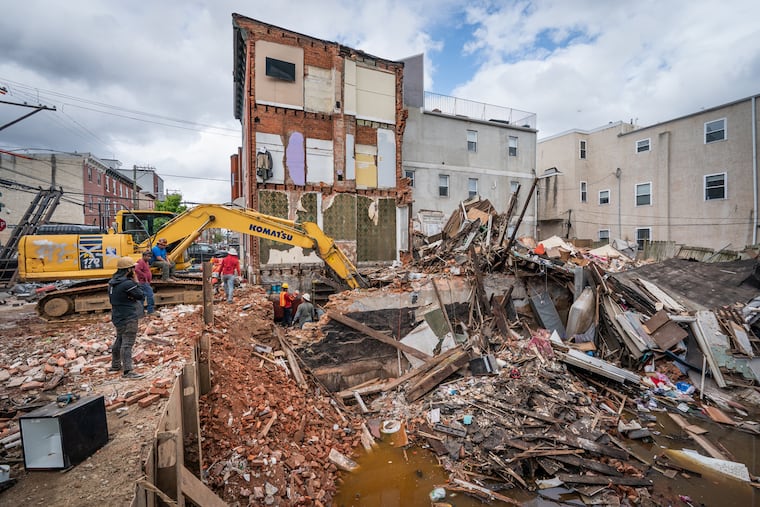Controller finds L&I is failing to track dangerous buildings or recover demolition costs
The controller’s audit found the city spends more than $11 million a year demolishing dangerous properties — more than $60 million since 2019. But it recoups only 3% of that.

The city’s process for identifying, monitoring, and demolishing dangerous buildings is riddled with inefficiencies, hampered by staffing shortages, and carried out at a high cost to taxpayers, who largely end up footing the $11 million-a-year bill for private owners’ neglect.
Those are the findings from a report issued Wednesday by Philadelphia’s City Controller Christy Brady, who pledged to prioritize digging into the city Department of Licenses and Inspections (L&I) last year in response to constituent feedback and an Inquirer series on how lax oversight has enabled dangerous construction practices.
“This investigation is about making our city safer,” Brady said at a news conference, describing the audit as just the first step in a sweeping probe into L & I’s construction oversight practices, the city building code, and widespread use of unlicensed contractors.
“We cannot wait for the next tragedy to occur,” she added. “We must protect our homes and our communities.”
The report focused on the city’s response to buildings deemed unsafe or imminently dangerous — and found that, in contrast to the serious life-safety threats posed by some imminently dangerous structures, the city’s response to them is freighted with delays.
Brady said she shared the findings with L & I Commissioner for Inspections, Safety and Compliance Basil Merenda. In a statement, Merenda said that Mayor Cherelle L. Parker had directed him to study and, to the extent possible, implement the report’s recommendations — which also would require action from the city Revenue Department and the court system.
“Our mandate from the mayor is a safer city, in which dangerous and imminently dangerous buildings are closely scrutinized, and all appropriate actions are taken to safeguard the public,” Merenda said.
» READ MORE: Controller pledges to audit L&I in response to Inquirer's 'Crumbling City' investigation
Demolitions must be approved through a court process that can take up to 90 days — and while inspectors are supposed to check on the dangerous properties every 10 days, a combination of severe understaffing and an inadequate tracking system appears to allow properties to fall through the cracks.
One condemned property highlighted in the report had a faded demolition notice that expired in 2023, bricks falling off of its rear wall, and evidence of people living inside.
Citywide, there are about 3,800 unsafe properties and 270 imminently dangerous ones, according to L & I data. Some properties may get those tags for reasons other than total structural failure, such as a crumbling retaining wall or a collapsing detached shed — but L & I’s software does not have the capability to sort dangerous properties by priority level, according to Brady.
Fifteen L & I staffers are assigned to the unit that monitors such structures and coordinates demolitions — putting the unit at 72% of its budgeted staff complement.
“This is the lowest it’s been,” Brady said. “Fifteen is not enough.”
The controller’s audit found that the city spends more than $11 million a year demolishing dangerous properties — more than $60 million since 2019. But it recoups only 3% of that from property owners, leaving liens on properties but doing little to enforce collections.
The controller offered a list of recommendations: Hire more staff to keep pace with the workload. Update the city’s relatively new eClipse software system to enable tracking and prioritizing dangerous buildings. Create a collections process to recover the $25,000 to $30,000 cost of each demolition. And, work with the city’s court system to address the delays.
Parker’s administration broke up the oft-criticized L & I into two divisions earlier this year, each with its own commissioner. One department will focus on inspections, safety, and compliance; the other on “quality of life” issues and business code enforcement.
When announcing her decision, Parker cited the Inquirer’s “Crumbling City” series of stories about how Philadelphia’s surging housing redevelopment has led to construction safety issues.
» READ MORE: Five fixes for Philly's construction chaos